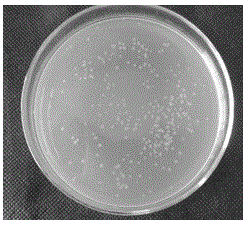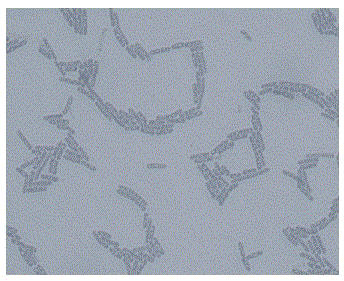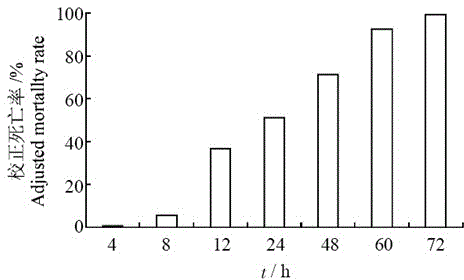Bacillus firmus for killing plant parasitic nematodes, and preparation method and application thereof
A technology of bacillus and nematodes, applied in the field of bacillus firmus and its preparation, can solve the problems of strong killing ability, difficult selection process of resistant varieties, poor selectivity, etc., achieve strong ecological adaptability, maintain insecticidal virulence, and long-lasting effect
- Summary
- Abstract
- Description
- Claims
- Application Information
AI Technical Summary
Problems solved by technology
Method used
Image
Examples
Embodiment 1
[0027] This embodiment includes Bacillus firmus wild-type strain Bacillus firmus The separation and Gram staining of YBf-10, the following is the specific implementation process: collect seabed mud from near the southern islands and reefs in the South China Sea, at an altitude of -812 meters, east longitude 115°29.4, north latitude 09°51.76, and use sterile water in the laboratory Suspend, heat to 80°C, use an inoculation loop to dip the suspension in LB solid medium (yeast powder 5 g, peptone 10 g, sodium chloride 10 g, agar powder 20 g, dissolve in 1 L single distilled water, 121°C , 20 min condition damp heat sterilization) was diluted and streaked for isolation, cultured at 28°C for 48 hours, picked a suspected single colony from the plate, diluted and streaked again on the LB plate, cultured at 28°C for 48 hours, and separated repeatedly The purified suspected single colonies were inoculated into LB liquid medium shake flasks, cultured at 28°C, 180 rpm, for 36 h, and 50...
Embodiment 2
[0038]In this embodiment, the 16S rRNA gene is obtained by using the isolated bacterial strain, and the phylogenetic tree is constructed. The specific implementation process is as follows: Bacillus firmus YBf-10 strain was activated overnight, inoculated with 1% (V / V) inoculum into fresh LB medium (Sambrook et al., 1989), and cultivated to OD 600 =0.3, collect the cells by centrifugation, and extract genomic DNA according to the operation method of TaKaRa MiniBEST Bacterial Genomic DNA Extraction Kit ver. 2.0. Using the genomic DNA as a template, bacterial 16S rRNA universal primers (27f: AGAGTTTGATCCTGGCTCAG; 1492r: ACGGCTACCTTGTTACGACTT) were used to amplify. The PCR reaction system was (25 L): 10× amplification buffer (with Mg 2+ 1.5mmol / L) 2.5 L, dNTP 0.5 L, each primer concentration is 0.2 L, template DNA 0.1 L, Taq DNA polymerase 0.1 L, add double distilled water to 25 L; Amplification conditions: pre-denaturation at 94°C for 4 min, denaturation at 94°...
Embodiment 3
[0042] The specific implementation process of this embodiment:
[0043] (1) Strain culture and bioassay sample preparation: cultured in LB medium (pH 7.0) Bacillus firmus The spores of YBf-10 strain were fully mature after 36 h. During this period, 2 mL samples were taken at different intervals until the spores were fully mature. The samples taken at each period were measured for OD 600 The growth curve was drawn, and the supernatant was collected by centrifugation to remove the spores. use 0.2 m membrane filter and save for biological assay samples.
[0044] (2) Obtaining the second instar larvae of M. northernis: Meloidogyne hapla ) (Greenhouse Artificial Culture and Propagation) severely infected tomato roots, rinse the surface sediment with tap water, remove the egg mass from the root with pointed tweezers, disinfect the surface of the egg mass with 0.5% (V / W) NaClO for about 5 min, and then use Rinse with sterile water repeatedly. After incubation at 25°C for 4...
PUM
 Login to View More
Login to View More Abstract
Description
Claims
Application Information
 Login to View More
Login to View More - R&D
- Intellectual Property
- Life Sciences
- Materials
- Tech Scout
- Unparalleled Data Quality
- Higher Quality Content
- 60% Fewer Hallucinations
Browse by: Latest US Patents, China's latest patents, Technical Efficacy Thesaurus, Application Domain, Technology Topic, Popular Technical Reports.
© 2025 PatSnap. All rights reserved.Legal|Privacy policy|Modern Slavery Act Transparency Statement|Sitemap|About US| Contact US: help@patsnap.com



